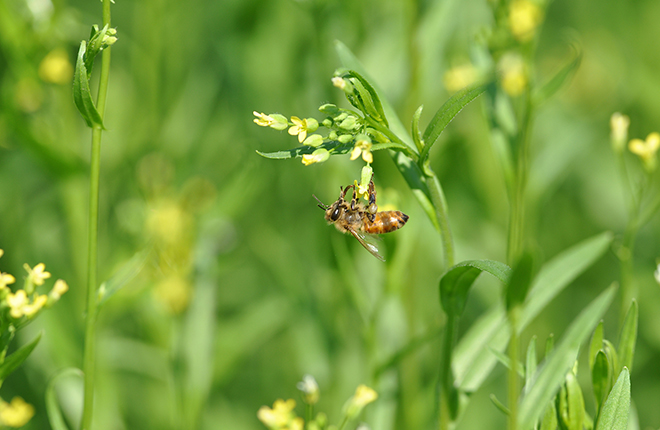Camelina Holds Promise for Biofuel and Bees
Once considered a weed, camelina is finding favor in some parts of the country as a soil-protecting winter cover crop. Oil from the seed of this yellow-flowered, herbaceous member of the mustard family can also be made into first-rate cooking oil and high-quality biodiesel, offering a renewable alternative to using imported petroleum for that fuel. (See “ARS Researchers Flying Higher with New Jet Fuels,” Agricultural Research, September 2012).
Over the past decade or so, Agricultural Research Service scientists at several locations across the country have conducted multi-faceted studies aimed at making novel oilseed crops like camelina more profitable for farmers to grow, easier for industry to process, and better performing as finished biofuels or other products.
At ARS’s Soil Management Research Unit in Morris, Minnesota, a chief focus has been evaluating and integrating the use of camelina, canola, pennycress, and other oilseeds into the production systems of traditional midwestern crops, notably corn and soybeans. This past spring, the scientists published some of their research findings, which include potential gains for farmers and improved health for insect pollinators, like bees.
In one study, published in the April issue of Agronomy Journal, ARS plant physiologist Russ Gesch and ARS soil scientist Jane Johnson examined the seasonal water use of double cropping and relay cropping, which is a strategy that overlaps the growth of winter camelina and soybean. Among their findings:
• Under natural rainfall conditions, relay cropping (in which the soybean crop is seeded between rows of growing camelina plants) used less water than double-cropping (whereby soybean seed is sown right after a camelina harvest, around mid to late June).
• Relay cropping camelina-soybean also used only slightly more water than a full-season soybean-only control treatment.
• Relay-cropped camelina resulted in higher soybean yields than sequential double cropping.
• Relay-cropped soybean yields ranged from 58 percent to 83 percent of yields for the full-season soybean; however, the camelina seed yields more than compensated for any loss in soybean yield. Furthermore, the total oil yield for the relay system (camelina oil plus soy oil) was 50 percent greater than a full-season soybean crop.
• Net economic returns of relay cropping were found to be competitive with those of full-season soybean, while adding the benefits of a cover crop.
• Before it is harvested for its oil, camelina cover crops may offer a way to “mop up” excess soil moisture that goes unused before soybeans are planted, especially in rain-fed farming areas of the Midwest. In the absence of cover crops, excess moisture during fall and early spring often leads to leaching and runoff of nitrogen into ground and surface waters, where it becomes a pollutant, explains Gesch.
• The study demonstrates a sustainable way to grow crops for both food and fuel on the same parcel of land, potentially offering farmers a dual source of income in a single season.
In a related study, published in the June 2015 issue of Industrial Crops and Products, postdoctoral researchers Carrie Eberle and Matt Thom, together with ARS agronomist Frank Forcella and their collaborators, showed that the flowering periods of camelina, canola, and pennycress can provide honey bees and other insects with a critical, early-spring source of nectar and pollen that’s usually unavailable then—especially in Minnesota, South Dakota, and North Dakota, where about one-third of the nation’s managed bee colonies are kept from May through October.
“Fields of winter camelina and winter canola produce about 100 pounds per acre of nectar sugar over the course of a 2- to 3-week flowering season. That quantity produced in such a short time is enough to support the annual energy requirements of a typical bee hive, which is 100-200 pounds of sugar per year,” notes Forcella.
Other results of the 2012-2014 study are as follows:
• Insect counts showed that the three oilseeds also attracted other pollinators, including wild bee species, butterflies, beetles, and hoverflies, whose larval stage feeds voraciously on aphids.
• Insects visited flowering canola up to 15 times more often than pennycress and camelina, perhaps because of higher nectar levels in each individual flower, which are much larger than those of camelina and pennycress.
• Canola failed to bloom during one of the study years, which is a reflection of its being less cold-hardy than the other two oilseeds.
• Camelina earned the highest marks overall, thanks to a combination of excellent cold tolerance, high seed yield, good ground cover, and high nectar production (89 pounds per acre).
“Continued efforts to improve yield and crop characteristics will help establish these crops (especially camelina and pennycress) as legitimate cash cover crops for the Northern Corn Belt,” Eberle and her coauthors write in their journal paper. “And as the demand to produce biofuels continues to increase, we may also expect to see an increase in their seed values,” benefiting farmers and bees alike.—By Jan Suszkiw, Agricultural Research Service Information Staff.
“Camelina Holds Promise for Biofuel and Bees” was published in the November 2015 issue of AgResearch Magazine.
Key Facts
- Intercropping camelina and soybean can mean dual profit.
- The strategy addresses food versus fuel concerns.
- Oilseed flowers offer early-spring food for pollinators.
- Oilseed cover crops help reduce soil erosion and offer other benefits.
Full Story








